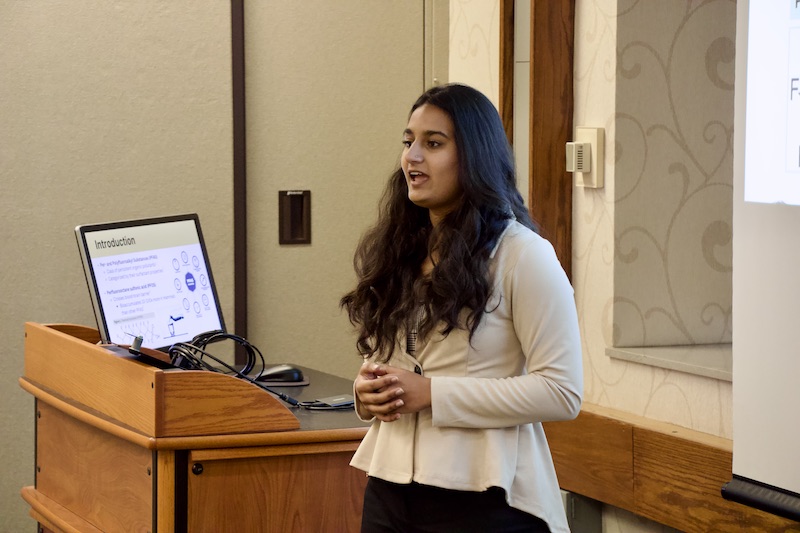Purdue Health Sciences lab explores PFOS’ effects on human motor behavior, mental health

Hurshal Pol gives a recent research presentation on the effects of perfluorooctanesulfonic acid, better known as PFOS, on humans.Tim Brouk
Written by: Tim Brouk, tbrouk@purdue.edu
“Has anyone eaten any food in the last month?”
The perplexing question was offered by Purdue University Health Sciences sophomore Hurshal Pol during the introduction of her Nov. 15 research talk in Purdue’s Stewart Center. Befuddled, the students, faculty and staff in attendance looked at each other, and some sheepishly raised their hands. Pol, who represented the College of Health and Human Sciences (HHS) well while earning an award during the day-long Fall Undergraduate Research Expo, explained that if someone consumed food, they likely had a side of per- and polyfluoroalkyl substances (PFAS) — a class of persistent, organic pollutants that can accumulate in the human brain. PFAS sources include food packaging and nonstick cookware, and U.S. companies have been using PFAS in their products since the 1940s.
“PFAS is everywhere. It gets in your water and in your food,” Pol said. “The first step with this is to get the word out that this chemical exists and what exactly it is.”
Many PFAS may not accumulate at sufficient levels in humans to cause toxicity. There are probably trace amounts in your body right now. However, perfluorooctanesulfonic acid (PFOS), a dangerous PFAS chemical compound if consumed in large quantities, can cause problems for the human body. Further, we have little toxicity data for the vast majority of PFAS, where we are unsure of what levels are safe.
Once heavily used in stain-, grease- and water-resistant products, PFOS was phased out in the early 2000s, but it is a legacy pollutant. PFOS can be found in some drinking water due to dumping or runoff from property near water sources decades ago. The chemical is practically immortal with half-lives of many years, and it does not metabolize in the human body.
Working in professor Jason Cannon’s lab, Pol explored the synthetic chemical’s effect on motor behavior. Cannon, Pol and her research mentor, PhD candidate Josephine Brown-Leung, hope to elevate awareness that could eventually get PFAS eradicated. They are looking at PFOS’ connection to mental health too because PFOS targets dopaminergic pathways which may lead to motor disorders, such as Parkinson’s disease, and neuropsychiatric disorders, such as ADHD (attention deficit/hyperactivity disorder) and major depressive disorder.

Josephine Brown-Leung, right, shows Health Sciences sophomore Hurshal Pol new electrochemical detection equipment in Jason Cannon’s lab.Tim Brouk
Mental health
By interacting with dopamine and serotonin levels in the brain, PFOS could affect humans’ mental health. Cannon said PFOS affects these systems in the brain in a way that could perpetuate or increase levels of depression and anxiety in someone exposed to large amounts of PFOS.
“It seems like PFOS is still the one that we’re finding at the highest concentrations in the brain,” Cannon said. “The data shows that it really seems to have the most effects on the brain. Despite it not being used anymore, that’s the main reason why we focus so heavily on that specific one. It’s going to be with us for a long, long time.”
Cannon is now collaborating with Dan Foti, associate professor in the Purdue Department of Psychological Sciences, and others through a newly funded NIH grant (Cannon and Foti are multi-PIs) to measure PFOS levels of those suffering from anxiety or depression.
“It’s just now that we’re learning about all the adverse effects on the nervous system,” Cannon said. “We do have a pretty solid body of literature suggesting that high-level exposures can lead to alterations in neurotransmissions.”
Motor behavior
Pol first entered Cannon’s lab as a senior at West Lafayette High School after an online search of neuroscience at Purdue. After shadowing and getting trained up, Pol joined the lab officially as a first-year Purdue student. Now in her second year, research is a major presence in her academic journey.
“I’ve been interested in neuro research for quite a while,” Pol said. “I was really interested in neurodegeneration research because it’s such an unknown mystery despite so much research on it. … This work is a great bridge between environmental science, public health, actual neuroscience, biology, chemistry, all of it.”
Using mouse models for the past 17 months, Pol and Brown-Leung tainted the rodents’ drinking water with different measurements of PFOS. Then, the mice’s exploratory activity levels in a box were measured over an hour. Motor function was measured as mice traversed a wire-mesh-covered beam. PFOS-treated mice required significantly more time to traverse the beam. Male mice had significantly increased errors in their steps and total errors compared to female mice with no effects of PFOS treatment.
Pol will be adding to her research this semester and sending the paper for publication.
United against PFAS
Numerous Purdue programs beyond HHS are studying PFAS. Cannon cited colleagues such as fellow Heath Sciences professor Jennifer Freeman; Linda Lee, Purdue professor of environmental and ecological engineering; Maria S. Sepulveda, a professor in the Department of Forestry and Natural Resources; and many others doing work to expose various harmful chemicals in the PFAS family as dangerous.
While Cannon and his team study PFOS, Brown-Leung said PFAS needs to be acknowledged in the same manner as dangerous pollutants such as DDT, polychlorinated biphenyls (PCBs) and bisphenol A (BPA) were years ago. While many PFAS are no longer made, like PFOS, the chemicals remain and remain dangerous if ingested in large quantities.
“They are still in our environment,” Brown-Leung explained. “We’re all exposed to complex mixtures of PFAS that’s very difficult to capture in experimental models. … This is the cutting edge right now. Everyone’s starting to realize we need to look at the interaction of the PFAS exposure and the psychiatric disorders.”
Cannon, Pol and Brown-Leung’s study puts the dangers of PFOS in an academic spotlight, which will be added to various PFAS studies that could write new policy. Their goal is to get PFAS to action level from the Environmental Protection Agency like lead and other toxicities have been over the decades using data and science to demonstrate its danger to humans.
“Even in other classes, I’ve kind of been spreading the word about PFAS,” Pol revealed. “I think once you start really diving into it, you start seeing that it’s almost everywhere. I think it’s important to do our part to stop it or at least educate our community about it. What can we do to prevent that exposure. Unfortunately, there isn’t much we can do now unless it goes up to legislation.
“It feels great to be a part of something that could have such a great impact in the future.”